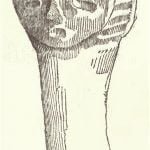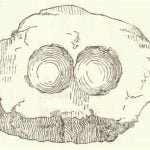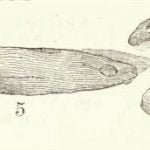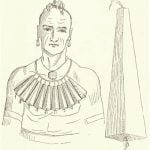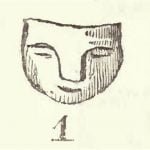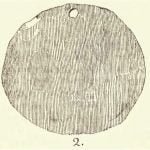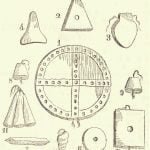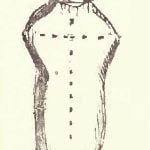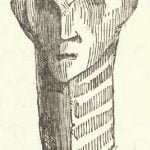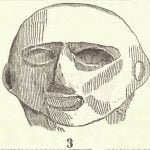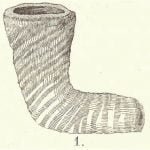Class First. Nabikoáguna. 1
Objects of this kind were worn as marks of honor or rank. So far as known, they were constructed from the most solid and massy parts of the larger seashells. Few instances of their having been made from other materials, are known, in our latitudes. The ruins and tombs of Central and South America have not been explored, so far as is known, with this view. Nor have any insignia of this character been found of stone.
Nabikoáguna Antique. Fig. I., Plate I. This article is generally found in the form of an exact circle, rarely, a little ovate. It has been ground down and re-polished, apparently, from the sea conch. Its diameter varies from three-fourths of an inch to two inches. Thickness, two-tenths in the center, thinning out a little towards the edges. It is doubly perforated. It is figured on the face and its re verse, with two parallel latitudinal, and two longitudinal lines crossing in its center, and dividing the area into four equal parts. Its circumference is marked with an inner circle, corresponding in width to the cardinal parallels. Each division of the circle thus quartered, has five circles with a central dot. The latitudinal and longitudinal bands or fillets, have each four similar circles and dots, and one in its center, making thirty-seven. The number of these circles varies, however, on various specimens. In the one figured, they are fifty-two. The partial decomposition of the surface renders exactitude in this particular sometimes impossible. This article was first detected, many years ago, in a medal, one and a half inches diameter, found in an ancient grave on the Scioto, in Ohio, and was supposed to be a kind of altered enamel or earthen ware. The structure of the shell is, however, present in all cases, in its center. Its occurrence, the present year, in the ancient fort grounds and cemeteries of Onondaga, identifies the epochs of the ancient Indian settlements of Ohio and western New York, and furnishes a hint of the value of these investigations. A medium specimen was examined, in the possession of I. Keeler, jr., Jamesville, very much obliterated; another, of the minimum size, at James Gould’s, Lafayette. The largest specimen seen, is one sent by I. V. V. Clarke, from Pompey and Manlius. The Indians have no traditions of the wearing of this species of shell medal, so far as known. It must be referred to the era preceding the discovery.
Nabikoaguna Iroquois. Fig. 2, annexed. This article consists of a metal, which is apparently an alloy. It is slightly ovate, and is perforated in the rim, so as to have been hung transversely. Its greatest diameter is two and four-tenth inches. There are no traces of European art about it, unless the apparent alloy be such. Locality, Valley of Genesee River.
Nabikoáguna Cameo, Fig. 3, 4. Plate III. This well sculptured article, was discovered in the valley of the Kasonda creek, Onondaga county. The material is a compact piece of sea shell. It still possesses, in a considerable degree, the smoothness and lustre of its original finish. Fig. 4 shows the prominence of the features in pro file. At the angles of the temples are two small orifices, for suspending it around the neck. The entire article is finished with much skill and delicacy. [Mifflin Gould.]
Nabikoáguna Mnemonic. Fig. 1, plate IV. This is the head of an infant represented in the fine red pipe-stone from the Missouri. Locality, site of the ancient fort of the Kasonda valley. [I. Keeler, junior.]
Class Second. Medäeka
This class comprises the amulets proper. All the objects of this class are supposed to have been worn on various parts of the person, as a defense against witchcraft, sorcery, or spells, or to propitiate good luck by superstitious means.
Medaeka Missouric. See Fig. 1, Plate V, with the illustration of the manner of its being worn on the breast. This article varies moderately in length, breadth and figure. It is generally the frustrum of an acute pyramid, perforated in its length, to admit being suspended from the neck, or ears. The figure exhibited is three inches in length by two-tenths in breadth at its superior, and nine-tenths at its inferior extremity. Sometimes, as in the figure given, it has a raised surface in the direction of the perforation. It is formed of the red pipestone of the Coteau Des Prairie, west of the Mississippi; and its disinterment from Indian graves in western New York, denotes an early traffic or ex change of the article, or rather the material of its construction, with the tribes in that quarter. This stone is fissile, and easily cut or ground by triturating with harder substances to any figure. It bears a dull gloss not a polish, which was produced by rubbing the surface with the equisetum, or rush, which has a silicious gritty surface. It is of the period anterior to the introduction of European arts. The specimen figured is from Onondaga County, [I. V. V. Clarke.] It occurred also at Oswego, in removing the elevation of the old fort, [J, McNiel] Also, at Lower Sandusky, Ohio. [L. Cass.]
Medaeka Dental. Fig. 4, 5. Plate VI. Fossil specimens of the bear’s tooth. A power against charms or spells was often attributed to amulets of this kind. The two species, very different in size, and of course the age of the animal, were obtained from a single grave. Valley of the Genesee River. [E. Trowbridge.]
Medaeka Okun. Fig. 3, Plate VI. This species is made from a compact kind of bone, squared and perforated. Valley of the Genesee River. [E. Trowbridge.] From an ancient grave.
Class Third. Attajeguna 2
Under this class are grouped a great variety of implements and instruments of utility, war, hunting and diversion. The material is chiefly stone. Without plates, however, it is impossible to give that exactitude to the description of this numerous class of antiquarian remains which is desired. But a single figure has been prepared Attajeguna Deoseowa. This relic of Indian art was pointed out to me by Mr. Wright, missionary on the Seneca reservation, near the city of Buffalo. It consists of a block of limestone, having two spherical basin-shaped depressions. It is the tradition of this people that in this ancient mortar, the female potters of olden time pounded the stone material with which they tempered the clay for the ancient akeek or cooking vessel. The original stone had been broken. From the portion of which the annexed is a figure, the entire mass must have been one of considerable weight.
Class Fourth. Opoaguna
The class of antique pipes. Smoking pipes, constitute a branch of Indian art, which called forth their ingenuity by carvings of various forms of steatite, serpentine, indurated clay, limestone, sandstone and other bodies. A very favorite material was the red sedimentary compact deposit, found on the high dividing ridge between the Missouri and Mississippi, called the Coteau du Prairie. Pipes were also made from clay, tempered with some siliceous or felspathique material similar to that used in their ancient earthenware.
Opoaguna Algonquin. Fig. 11. The composition of this pipe is a compact brown clay, tempered with a fine siliceous matter, and dried in the sun, not baked in a potter’s oven. The exterior is stained black, and bears a certain gloss 7 not a glazing. The bowl has been formed by hand, and is rude. The principal point of skill is evinced in the twist ornamenting the exterior of the bowl. Locality, Genesee River Valley.
Opoaguna Aztec. Fig. 12. The material is a species of Terra Cotta, or reddish earthenware. Its fracture discloses very minute shining particles, which appear to be mica. Probably the ingredient used to temper the clay, was pounded granite. The features resemble, very strikingly, those of Mexico and Central America, figured by Mr. Catherwood Stephens. Onondaga County.
Opaguna Iberic. Fig. 13. Material, a slate colored ware. Features thin and sharp. Neck, acute in front, with an angular line extending from the chin downwards. Onondaga.
Opoaguna Etruscan. Fig. 14. Material similar to O. Azteek. Figure double headed heads alike, placed back to back, like the Grecian deity Janus, connected by five parallel fillets, bowl rudely formed, by hand. Onondaga.
Class Fifth. Minace 3
Articles of this kind hold the relative character of modern beads or necklace ornaments. They are made of shells, bones, fissile minerals, sometimes pieces of calcareous or fissile crystal. The substitutes of the European period are glass and pastes.
Minace Alleghanic. Fig. 1, Item 6. This article was first disclosed on opening the Grave Creek mound, in the Ohio valley, in 1839, and received the false designation of “ivory.” It is figured and described in the first volume of the Transactions of the American Ethnological Society, published at New York in 1845, where its character is determined. It has often the appearance of having been formed of solid masses of horn. It is believed to be, however, in any case, a product of massy seashell. Decomposition gives its surface a dead white aspect and limy feel. The powder scraped from the surface effervesces in acids. It is generally, not uniformly, an exact circle, and resembles extremely a very thick horn button-mould. It is characteristic of the orifice, that it appears to have been perforated with an instrument giving a spiral or circular line. This ancient ornament was also disclosed in my visit to the Beverly bone deposits of Canada in 1843. Its occurrence, in Onondaga, denotes the universality of the art, during the ante-European period.
Class Sixth. Peäga 4
The ancient species of this article are numerous, and not exclusively confined to seashells. The Indian cemeteries denote it in the form of bone and mineral.
Peäga Iowan. Fig. 1, Item 2. The material in this species is the red pipestone of the west, so much valued. It is perforated longitudinally, and was evidently worn about the neck and breast like the modern article of wampum.
Class Seventh. Mudwämina
Ornament alone appears to have been the object of this numerous class of remains. Generally the object was the production of a jingling sound in walking. It was generally used to decorate some part of the dress. It assumed a great variety of shapes, and was made from as many species of material, including native copper. Another object was to inspire fear by the tread.
Mudwämina Miskwabic. 5 Fig. 1, Item 11. The article figured is three-fourths of an inch in length, bell shaped, and composed of native copper, beat very thin. Onondaga.
Mudwämina Ossinic. 6 Fig. 1, Item 8. Material, red pipestone, perforated. Onondaga.
Mudwämina Wassäabic. Fig. 1, Item 9. Material, a crystal, perforated. Traces of its iridescence. Probably a crystal of strontian. Onondaga.
Class Eighth. Otoauguna
The name is derived from Otowug, meaning implements of, or relating to the ear. It is a noun inanimate in a. Under this head all pendants and ornaments for the ear are comprised.
Otoauguna Statuesque. Fig. 20, Plate IV. This pendant for the ear is made oat of sea shell. It bears eight perpendicular and four transverse dots. Locality, old fort, site near Jamesville, Onondaga.
Otoauguna Pyramidal. Fig. 1, Item 2. This article varies in size, in the specimens examined, from nine-tenths to one and five-tenths inch, in the greatest length. It is an in equilateral triangle, generally, as here shown, varying to a very acute truncated prism reversed. Thickness from four to six lines. Perforated. Material, red pipe stone. Locality, Onondaga County.
Otoauguna Bifurcate. Fig. 1, Item 4. Length eight-tenths inch. Perforated. Red pipestone. Onondaga County.
Otoauguna Quadralateral. Fig. 1, Item 5. Material, redpipe stone. Onondaga County.
Class Ninth. Æsa. 7
The number and variety of sea and sometimes fresh water shells worn by the ancient aborigines, has not been ascertained, but is large. They are uniformly found to be univalves.
Æsa Marginella. Fig. 1, Item 10. This species was first detected in the Grave Creek mound. It is a marginella. The figure is, incidentally, inexact. Onondaga.
Class Tenth. Ochalis 8
This class of ornaments were worn as pendants from the inner cartilage of the nose. The material of nose-jewels in modern times, when worn, is, generally, silver or some metal. Anciently bone or shell were the chief substances.
Ochalis Odä-ä 9 Fig 1, Item 3. The material is a part of some massy species of seashell. The outer coating is partially de composed, exhibiting an opaque, limy appearance. Length, eight-tenths of an inch rounded, heart-shaped. Onondaga. [J. V. V. Clarke.]
Citations:
- From the Algic, denoting a medal, a breast- plate or collar.[
]
- From the Algonquin Jeegun, an instrument, an implement, or any artificial contrivance, or invention.[
]
- From Meen, a berry; and ace, a diminutive; hence minas or minace, a bead, or an ornament for the neck.[
]
- From Peag, one of the sea-coast terms of the Algonquins, for wampum.[
]
- Copper.[
]
- Stone.[
]
- Aes, a generic name for a shell Algonquin.[
]
- From the Shawanoe word Ochali, a nose.[
]
- Heart-shaped, or like.[
]

